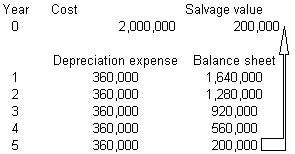
Once you have pinpointed the correct deposit, proceed with caution as the action is irreversible, unless utilizing the ‘undo’ or ‘reverse’ function. Make sure to double-check all details to ensure that the correct deposit is chosen for deletion. This is crucial to avoid any discrepancies cost of sales vs cost of goods sold in bank reconciliation and financial records. By mastering the process of deleting and voiding deposits in QuickBooks, you can effectively manage your financial transactions and ensure the accuracy and organization of your accounting records. Remember to exercise caution when performing these actions and consult with professionals if needed.
- If you accidentally enter the same deposit twice, it can result in a duplicate deposit.
- Verifying the nullification action ensures that any unintentional mistakes or erroneous selections are caught before finalizing the reversal.
- Enter the username and password that you have registered for your Quickbooks Online account.
- Voiding a deposit keeps the transaction visible in your records, but it will no longer affect your account balances or financial reports.
Whether it’s a duplicate deposit or a deposit for the wrong amount, it can impact your financial records and create a mess for your accountant. Fortunately, deleting incorrect deposits in QuickBooks is relatively straightforward, and with a few simple steps, you can have your records back on track. There are instances when it becomes necessary to delete a deposit in QuickBooks, such as errors in the recorded amount, duplicate entries, or the need to reverse a transaction.
How Do I Delete or Void in QuickBooks?
Once you have opened the Deposit Window, you can easily identify the deposit you want to delete by scanning the list of transactions. Click whats in a product warranty heres how to get the most out of them on the deposit to select it, then locate the ‘Edit’ option to make changes to the deposit. From there, you can choose to delete the deposit by clicking on the ‘Delete’ button. If you accidentally assign a deposit to the wrong customer, it can lead to inaccurate financial records and make it difficult to track your income.
Select the Deposit to be Voided
In this comprehensive guide, we have explored the process of deleting and voiding deposits in QuickBooks. We started by emphasizing the importance of understanding deposits in the context of QuickBooks and how they impact your financial records. We then provided a step-by-step guide on deleting deposits, ensuring that you follow the necessary precautions to avoid any unintended consequences. A deposit in QuickBooks refers to the process of adding funds into a bank account, typically from a customer payment or other sources of income. It is a crucial step in maintaining accurate financial records within the QuickBooks software. Before we delve into the process of deleting a deposit in QuickBooks, it is essential to have a clear understanding of what deposits are in the context of this accounting software.

How To Delete Bank Account In Quickbooks
This option is for when you have a reference number and a transaction type for a set of deposits. By inputting this reference, SaasAnt Transactions will directly pull up related transactions, eliminating the need for manual searches. Search and locate ‘SaasAnt Transactions’ to connect and integrate with QuickBooks. Once combined, SaasAnt will access your transaction data, streamlining the deletion of the records. Now that you have learned how to void a deposit as an alternative method, it’s crucial to consider some important considerations and precautions before proceeding. Whether you are a seasoned QuickBooks user or just getting started, our guide will help you navigate through the process smoothly.
Can I Delete a Transaction in QuickBooks?
Deposits can come from various sources, such as customer payments, loan proceeds, or investment income. Recording deposits in QuickBooks is essential for keeping track of your cash flow and ensuring accurate financial reporting. When you receive a deposit, you can enter it into QuickBooks, assign it to the correct account, and mark it as “deposited” so that it appears in your bank account balance. Having accurate deposit records in QuickBooks helps you track your income, reconcile your bank statements, and prepare tax returns. In QuickBooks, a deposit records money received into your business’s bank account. These deposits can come from various sources, such accrued interest as customer payments, loan proceeds, or investment income.
I cannot backspace in the “Received From” field because it takes me to the Sales Receipt. And if I try to change the customer name in the Sales Receipt window I get an error message because the Sales Receipt is linked to the deposit. Before that, the “uncheck the customer name” in step no. 8 means that removing the customer name in the RECEIVED FROM column. This extra step adds a layer of security and prompts users to be mindful of their actions within QuickBooks Online. Feel welcome to leave a comment below if you need more help in handling your other transactions.
Always double-check the transaction before finalizing the voiding process. With this information at your fingertips, you can proceed to undo, reverse, or edit specific deposit transactions as needed, ensuring accuracy and proper documentation within QuickBooks. Errors in the recorded amount may occur due to human input mistakes, or a deposit may need to be deleted to reverse an unintended transaction. Duplicate entries can clutter the records and affect overall financial visibility, prompting the need to delete the deposit. It is crucial to double-check the deposit you’re deleting to avoid any unintended consequences.




